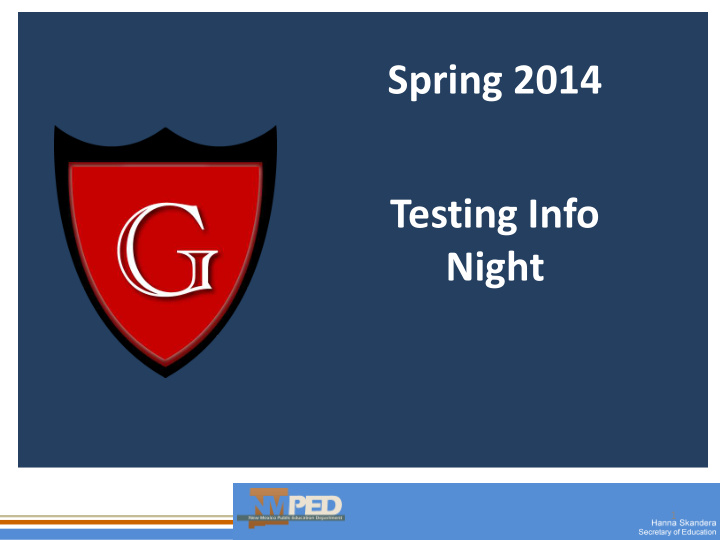



Spring 2014 Testing Info Night 1
What is the SBA? The New Mexico Standards Based Assessment (SBA) was developed in accordance with the following federal laws: Title 1 of the Elementary and Secondary Education Act of 1994, P. L. 113–382, and the No Child Left Behind Act (NCLB) of 2001. 2
What is the SBA? New Mexico students in grades 3 through 8, high school year 2 (H2), and high school year 3 (H3) participate in the New Mexico SBA in reading and mathematics, as well as science in grades 4, 7, and H3 and writing in grades 3, 5, and 8. 3
What is the SBA? The purpose of this assessment is to measure students’ achievement as articulated by New Mexico Assessment Standards, which are a subset of the broader New Mexico Content Standards with Benchmarks and Performance Standards. 4
What is the SBA? New Mexico SBA scores are intended to be useful indicators of the extent to which students have mastered material outlined in the New Mexico reading, writing, mathematics, and science content standards, benchmarks, and performance standards. 5
What is the SBA? Each student’s New Mexico SBA score should be used as part of a body of evidence regarding mastery and should not be used in isolation to make high-stakes decisions. 6
Assessment Requirements for HS Graduation Primary Demonstration of Competency • Math, Reading, Science: Pass SBA/HSGA • Writing and Social Studies: Pass 1 EoC
Assessment Requirements A student must attempt ALL administrations of the SBA/HSGA (H2, H3, H4 retakes) before implementing a passing EoC or other ADC score. Students may bank passing scores proactively. 8
Alternate Demonstration of Competency (ADC) ADC : Provides additional opportunities for students to meet assessment requirements. ADCs include : EoCs CCR Indicators See Graduation Checklist for options and CCR cut scores. 9
What is EoC? The End of Course exams are assessments that measure a student’s proficiency in a variety of subjects. The EoC is the primary way in which students can demonstrate competency in the areas of Social Studies and Writing, which are not assessed on the SBA or the HSGA. The EoCs in other subjects offer an alternative demonstration of competency (ADC) for students who do not show competency by achieving passing scores on the SBA. 10
What is EoC? EoCs will be administered the weeks of May 5 th • and May 12 th . • All students will be taking EoCs in one or more subjects. • Students are able to use their EoC grade in place of taking the cumulative exam for the second semester of their course. 11
EoCs—Purpose 1. To align course curricula (content, skills, rigor) statewide. 2. For HS students to meet graduation requirements 12
Alternate Demonstration of Competency (ADC) • If students do not demonstrate competency initially, they may use cut scores for one of the following as an ADC: » ACT » PLAN » PSAT » SAT » Accuplacer » COMPASS » IB Program » AP » EoC
EoCs as ADCs for High School Graduation • ADC for all subjects • Two chances to pass an ADC • Two total attempts in math, reading, science • Three total attempts in writing and social studies • May take during any established testing windows
EoCs for High School Graduation—ADCs MATH SOCIAL STUDIES Algebra I* Economics Algebra II NM History Integrated Math III U.S. Government Math ADC U.S. History World History and Geog. SCIENCE Biology WRITING Chemistry ELA III Writing ELA IV Writing READING ELA III Reading Student must pass Algebra II ELA IV Reading course to use Algebra I EoC.
EoCs for High School Graduation • There is no composite math/reading score for EoCs. • If students do not achieve the 73 composite score on the SBA, they must take EoCs in any subject(s) in which they did not achieve a proficient score.
Course Grades Algebra I 7‒12 Algebra II 10‒12 PED-Developed Biology 9‒12 Chemistry 9‒12 EoCs Economics 9‒12 English/Language Arts Reading 11 and 12 English/Language Arts Writing 11 and 12 General Computer Applications 9‒12 Health Education 6‒12 Integrated (General) Science 6‒8 Integrated Math III 10‒12 Introduction to Art 4‒5, 7‒8, 9‒12 Mathematics ADC 9 – 12 Music 4‒5, 9‒12 New Mexico History 7‒12 Physical Education 4‒5, 7‒8, 9‒12 Social Studies 6 6 Spanish I 9‒12 Spanish/Language Arts Reading 11 Spanish/Language Arts Writing 11 U.S. Government—Comprehensive 9‒12 U.S. History 9‒12 World History and Geography 9‒12 17
PED-Developed EoCs • Elementary, Middle, and High School • Paper-Based Assessments (PBA) • Student Performance Assessments (SPA) • Core and elective subjects • Developed by groups of NM Educators 18
EoC Testing Protocol • EoCs are downloadable from SOAP. • Maintain test security! • Do not maintain local digital copies. • Retain paper copies in locked, secure storage.
Growth Model “Student Achievement Measures” based on growth model. PED uses data of past student achievement to produce “projected score.” 20
Growth Model If actual student scores are higher than projected student scores, teacher receives a high rating for Student Achievement Measures. Model produces high correlation between predicted and actual scores. 21
EoCs Correlation between predicted and actual EoC at the student level = .86 At the teacher level = .94 22
Electronic Devices • School must clearly state 1) NO ELECTRONIC DEVICES DURING TESTING and 2) VIOLATION RESULTS IN CONFISCATION AND SEARCH OF DEVICE. If student is caught with device during testing: • TA collects device • Student continues testing (if possible) • TA gives device to STC/DTC/Principal • STC/DTC/Principal has phone checked for content • STC/DTC fills out Irregularity Report and submits to PED • Student reprimand: at discretion of school/district • 23
Questions? 24
Recommend
More recommend